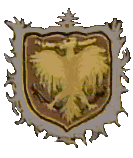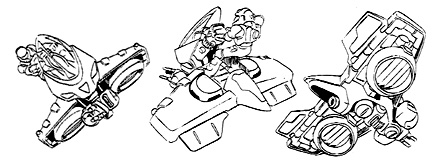

Designation:GMP Hoverplatforms
|

|
||||

|
|||||

|
|||||
| LHR-1 | LHT-2 | |
|---|---|---|
| Length : | 2.36 meter | 4.19 meter |
| Width : | 2.96 meter | 2.96 meter |
| Height : | 1.52 meter | 1.90 meter |
| Weight : | 1.90 metric tons | 2.40 metric tons. |
The armor of the GMP Hoverplatforms is composed of a plastic-ceramic composite for maximal resistance to penetration and thermic explosive damage for minimal weight. The armor stops most small arms fire, provides poor protection against heavier infantry weapons, such as a 12.7mm machinegun round. The platform itself provides minimal cover for the pilot, who is especially exposed from above.
As the Southern Cross completed its Hargun Combat Cycle prototypes in 2020, it became obvious that several problems would hamper its successful deployment. First, the engineers were having trouble with the collapsible arms and legs and opted to develop a special utility truck. The Hargun rider would ride the bike into the utility vehicle where the arms and legs would be attached while the motorcycle transformed.
Unfortunately, this posed a further problem - one of deployment. The main aspect of the Hargun Combat Cycle was its ability to utilize small and narrow passages to get to its destination or target. The truck, on the other hand, still required a fair-sized alley or road to accomplish the same. By 2023, it became obvious that either the Hargun system would have to be dropped, or a new type of insertion vehicle would be required.
By the same sort of coincidence which surrounded the development of the Beta, another section of the prototyping group was working on the development of a one-man patrol vehicle for the GMP to supplement the hover-cycle. The unit was a large flying platform, controlled by two trackballs at the pilot's feet as well as a free-floating console. Called the Flagga (the name's origin, like the Hargun's, is obscure), this hoverplatform would be ideal for urban patrol, and anti-insurgency work.
The Hargun team saw the platform as the perfect insertion vehicle and soon developed a variant for use with the Hargun. Fitted with a second engine, and an extended tail that stored large amounts of fuel, this platform could carry a Battloid to the target area, then release it from up to 14 meters in the air. It would also double as potential air support should the Hargun require it. In view of this secondary support role, the LHT-2's pilot would be in a sitting position, as well as being afforded more protection by the platform's own armor.
By 2027, 2450 LHR-1 Scout platforms and 1090 LHT-2 Insertion platforms had been manufactured. Unfortunately, the Hargun program was soon canceled, and the existing Harguns refit for use in space, leading to the retirement of the modified rapid insertion platforms. The Flagga never saw wide use either, as the anticipated insurgencies never occurred, and procurement was soon halted. Few of either vehicle survived to the Invid invasion, though several were known to have been used by occupation-era nations to discourage civil unrest.
Return to Southern Cross Aircraft Index.
Go to Robotech Reference Guide Home Page.
Robotech (R) is the property of Harmony Gold. This document is in no way intended to infringe upon their rights.
Content by Aubry Thonon, with Pieter Thomassen and Peter Walker